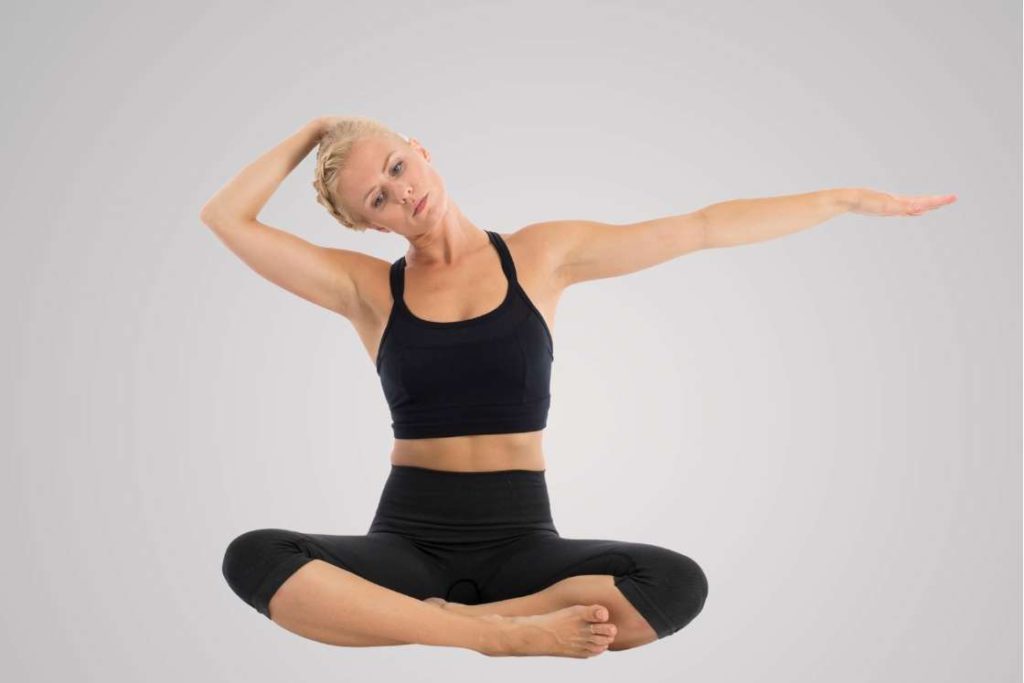
Feeling neck pain from long hours at your desk or too much screen time? Whether it’s poor posture, muscle tightness, or daily stress, neck pain has become a common issue for many. Yoga offers a simple, natural way to ease that discomfort.
In fact, a 9-week clinical study found that practicing Iyengar-style yoga can significantly reduce chronic neck pain. By gently stretching and strengthening the neck and upper back, yoga helps release built-up tension and improve posture without medication or side effects.
But why do neck muscles get tight?
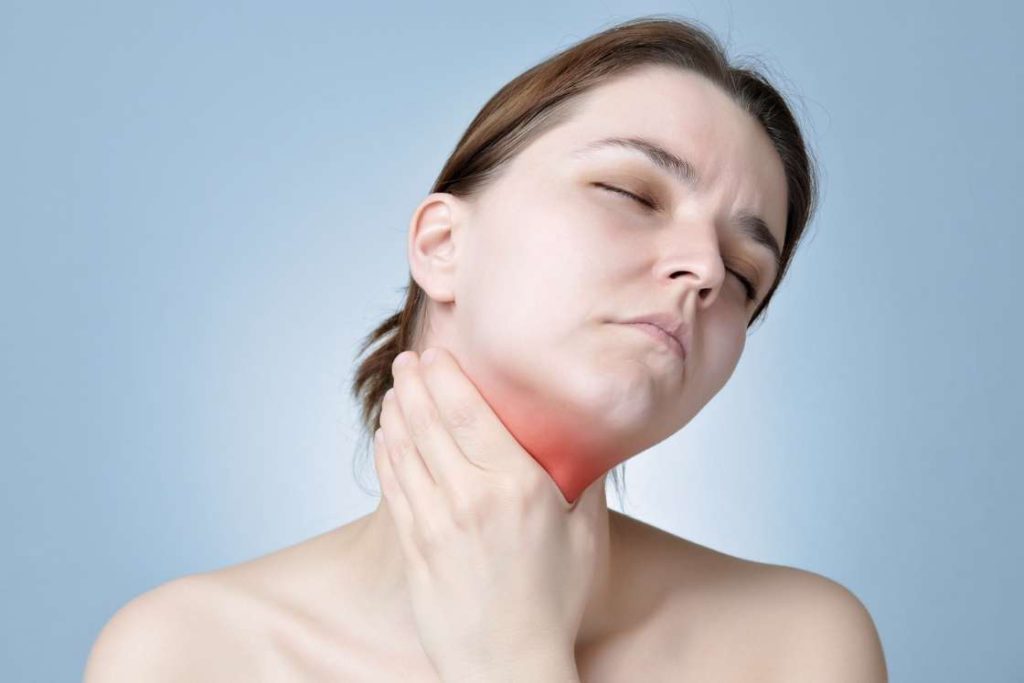
Spending hours on digital devices has a real impact on your posture. That’s why terms like “tech neck” have become common referring to the pain and strain in the neck muscles caused by constantly looking down at screens.
When your head tilts forward, even slightly, the neck can no longer properly transfer its weight to the spine. This places extra stress on the neck and shoulders, often leading to tightness, tension, or chronic pain.
According to a 2018 report by Harvard Health Publishing, about 7 out of 10 people experience neck pain at some point in their lives.
There are many causes of neck pain, and not all are easy to diagnose. In fact, a 2019 review found that yoga can help manage non-specific chronic neck pain by improving posture, reducing muscle stiffness, and easing tension.
To better understand what you’re experiencing, let’s look at the different types of neck pain and discomfort.
How yoga helps relieve neck pain
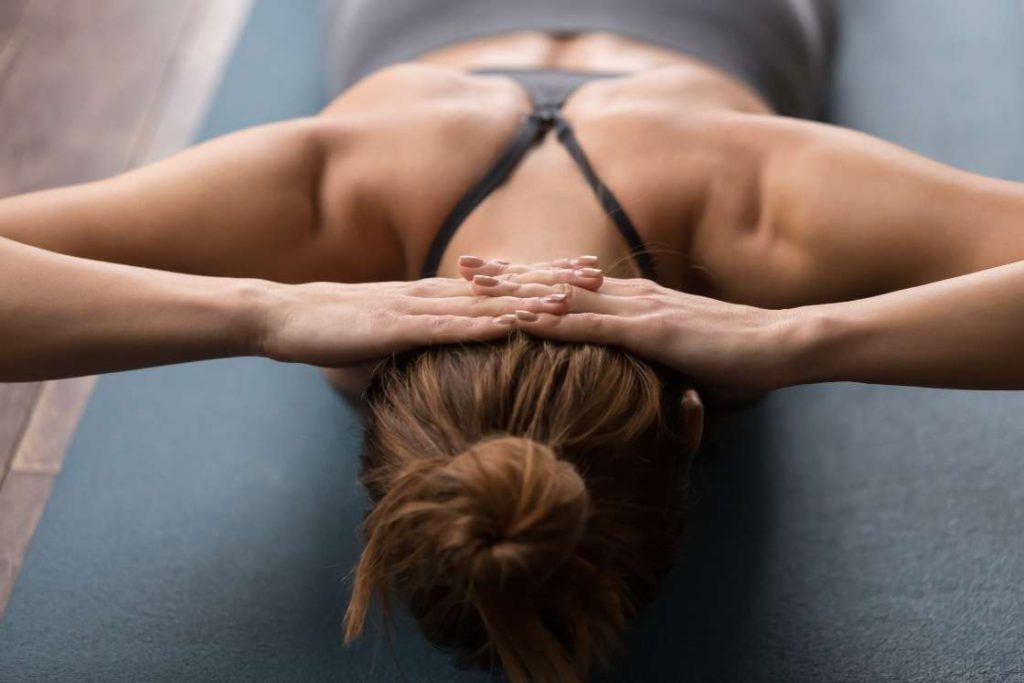
Yoga poses are ideal physical exercises that can help you maintain the correct position of your head, placing minimal strain on your neck and thereby preventing neck pain. Moreover, yoga provides a gentle stretch to the muscles surrounding the neck, helping to release the tension that causes discomfort.
This section outlines different types of neck pain along with their symptoms. It can help you identify the root cause of your neck discomfort and understand how yoga may assist in relieving it.
- Mechanical neck pain aka axial pain often occurs in the posterior region of the neck. This is the most common neck pain that one can experience and is often restricted to a particular region in the neck. Its major symptoms include stiffness headaches, surrounding muscle pain, or sensation. It can majorly affect the base of the skull, shoulders, or shoulder blades.
- Cervicalgia is the pain in the cervical spine that extends from the base of the skull to the thoracic vertebrae. The pain often extends to the head, arms, and back muscles. This generally results from bad posture, the overload of the neck muscles, or cervical injury accompanied by stiffness and spasms.
- Torticollis aka wryneck induces the head tilting towards one side of the neck. It occurs due to the tightness in the muscles on side of the neck. It causes difficulty and pain while turning the head, pain down the spine, and spasms of the neck muscles.
- Cervical Radiculopathy commonly referred as pinched nerve caused by nerve compression or irritation in the base of the neck. It causes sharp burning pain that begins at the neck and travels to the hand or finger followed by muscular weakness or loss of sensation.
- Referred neck pain is something that is triggered by pain in other body parts like the shoulder. Dr. Eric Ricchetti, MD, says, “People may come in with shoulder pain when they really have a neck problem.”
What research says?
Yoga has been proved to be effective in relieving neck pain in all these kinds of neck pain than physical therapy and other relieving exercises. It is proved in a 2017 research that yoga helps in alleviating neck pain, its symptoms, and disabilities arising due to it.
Another research was conducted in 2018 which stated that yoga is more effective in relieving the most common mechanical neck pain than Pilates and Tai chi.
Yoga poses for neck pain
If you’re looking to try yoga for neck pain relief, it’s best to begin with gentle warm-up exercises or a few rounds of Surya Namaskar (Sun Salutation) after waking up. Once your body is warmed up, you can move into specific poses that target the neck and upper back. You can always use props or make modifications to suit your comfort level.
Here are 8 effective yoga poses to help relieve neck pain:
1. Ear-to-shoulder stretch
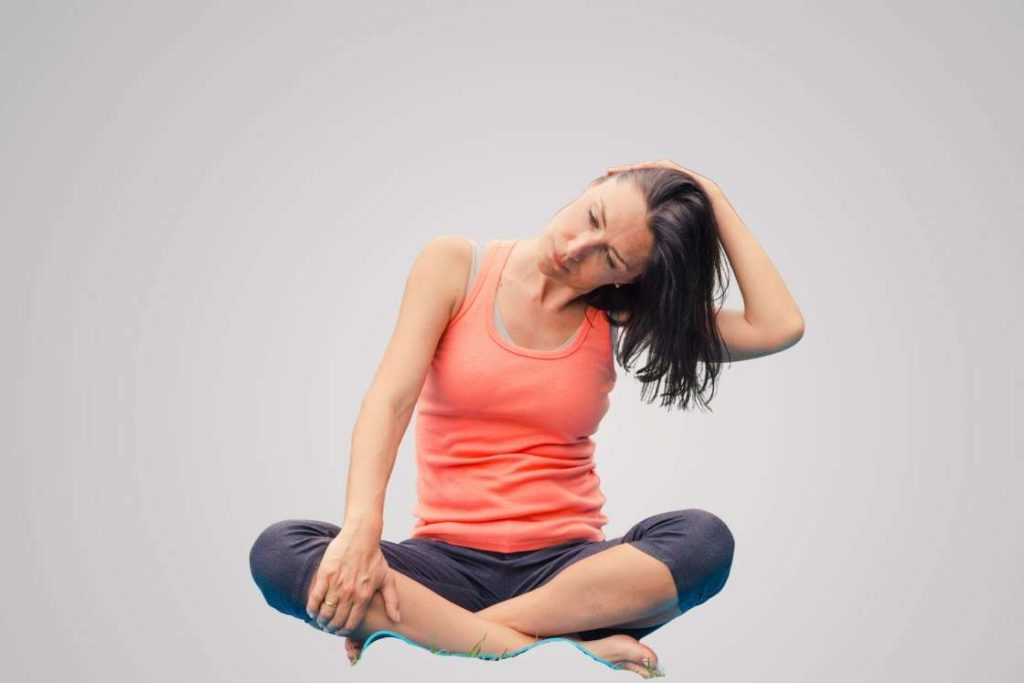
This is a gentle yoga stretch for the neck and shoulders, performed exactly as its name suggests. In this pose, the head is tilted to one side until the ear moves toward the shoulder.
It stretches the sides of the neck and helps release any stiffness or tension trapped in the neck muscles.
How to do
- Assume easy pose (sukhasana) or sit on a chair with an erect back and relaxed shoulders placing hands on the knees.
- Take your right hand and place the palm over the left ear.
- Gently push your head tilting it towards the right until your right ear touches the right shoulder.
- Then bring the head back to the center and release your hand.
- Repeat the same on your left switching the hands.
2. Eagle arms with chin tilt
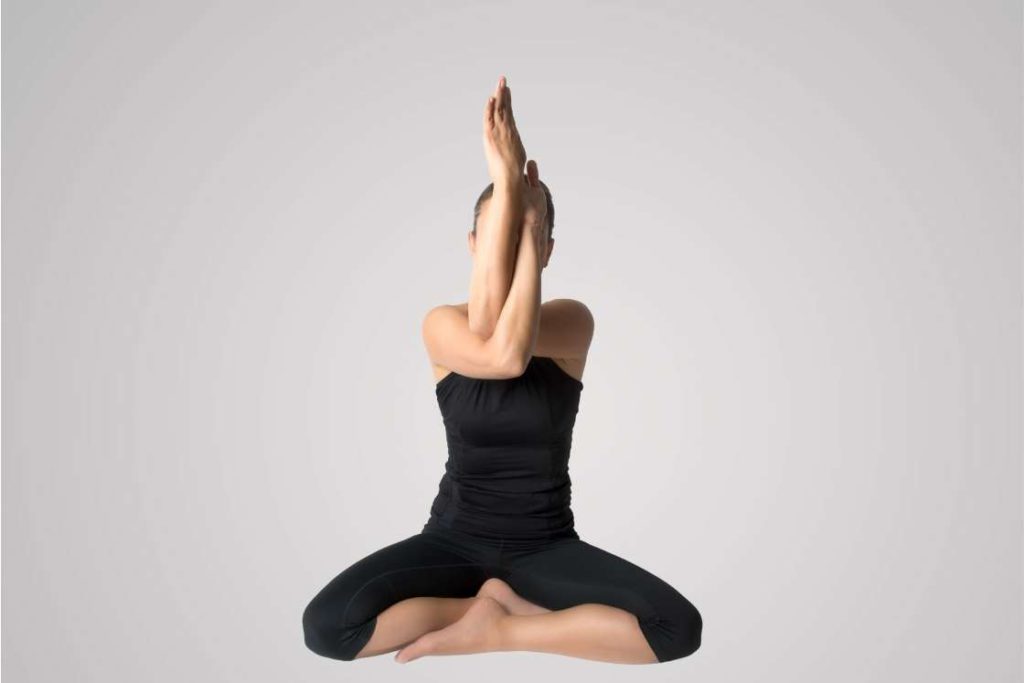
This modified version of eagle pose (garudasana) is practiced by tangling the arms in front of the face and then drawing the chin to the chest.
Eagle arms with chin tilt relieve neck pain by stretching the scalene muscles, i.e. sides of the neck. Besides this, it stretches the rhomboids and lower trapezius muscles which include shoulders blades, and upper back. Hence, it is one of the yoga asanas for neck and back pain as well as for “referred pain in the neck”.
How to do
- Assume a comfortable seated pose.
- Bring your arms in front and hook the right elbow in the left elbow’s crook.
- Tangle and squeeze the arms such that the palms are joined in front of the face.
- Now, try to tilt your chin towards the chest slightly.
- Hold it for a while and then release the neck and arms.
3. Thread the Needle Pose
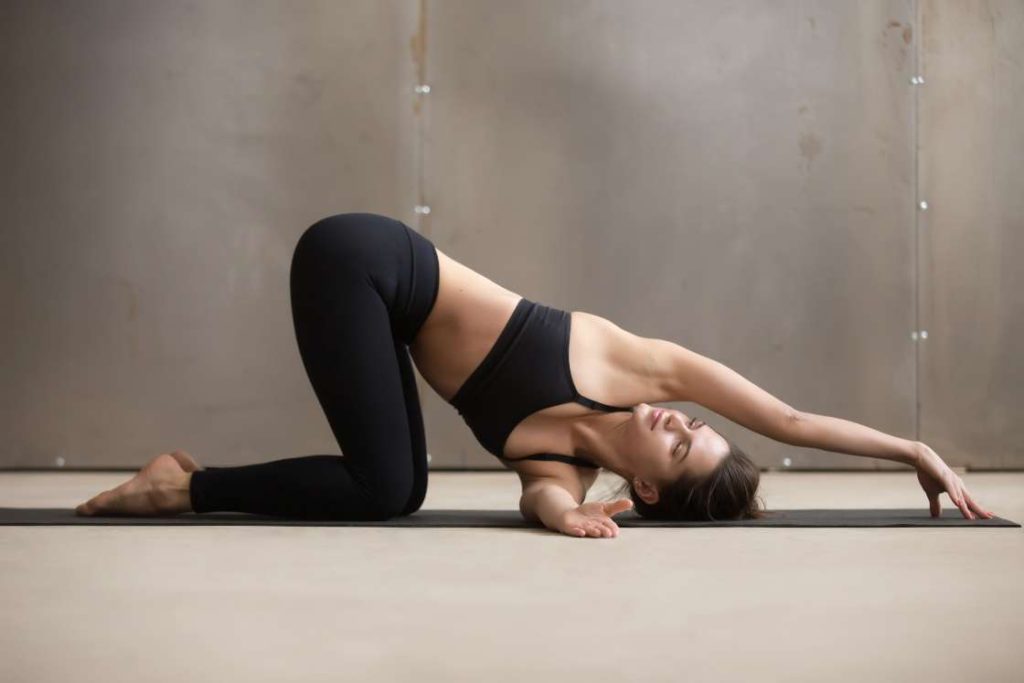
Thread the Needle Pose is performed by sliding one arm underneath the other—similar to the action of threading a needle while lowering one shoulder toward the floor from a tabletop position. Placing a neck roll or folded blanket under the neck can make the pose more comfortable and support relief from neck pain.
This gentle twist stretches the spine, shoulders, arms, and neck. It helps ease radiating neck pain that extends to the upper back or arms, reduces stiffness, and relieves tension between the neck, spine, and shoulders.
How to do
- Begin in table-top position bringing the knees under the hips and wrists under the shoulders.
- Lift your right hand off the floor and pass it to the left under the left arm with right palm facing up.
- Press your left palm against the floor and pass the right arm to the left until the right shoulder comes to the floor.
- Simultaneously turn your neck and rest it over the neck roll to look towards the left.
- Hold the pose as such for 30 seconds and then come up to rest in child’s pose for a few breaths.
- Repeat it on the other side.
4. Extended triangle pose
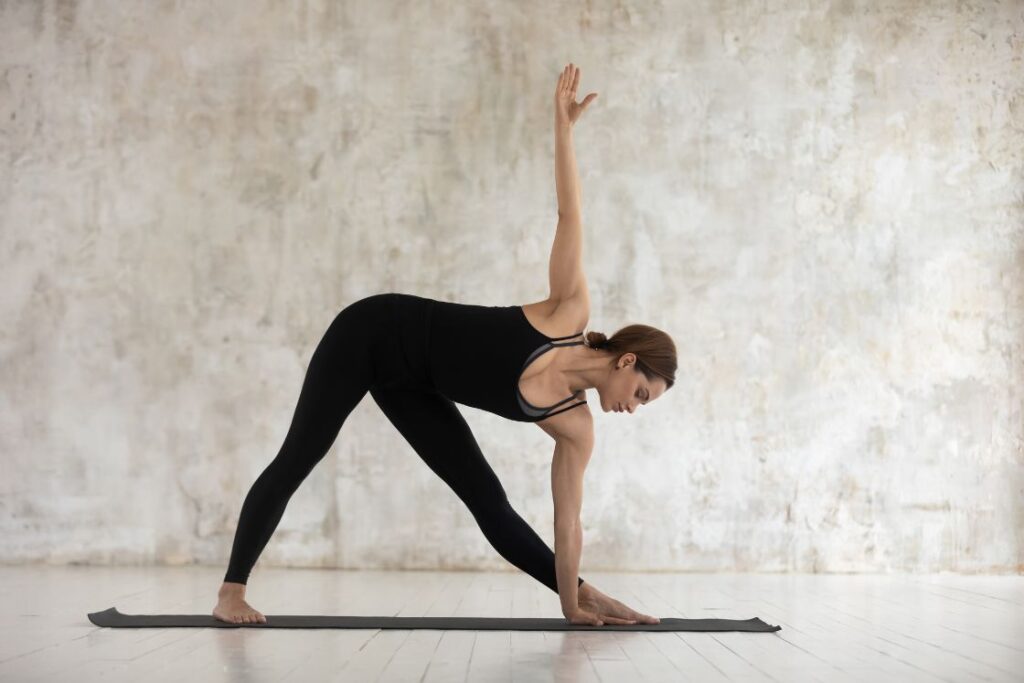
To assume triangle pose the torso undergo an asymmetrical forward bend stretching the back, neck, and leg muscles.
Extended triangle pose is one of the best yoga asanas for the cervical spine as it relieves tension and pain in the neck, upper back, and shoulders. Thus, it can be practiced to relieve cervicalgia or cervical radiculopathy type of neck pain.
How to do
- Take a stance by separating the legs more than hip-width apart.
- Turn your right toes 90° to the right and rotate the torso towards the right.
- Open your arms at shoulder level with palms facing the floor.
- Bend forward at your hip lowering the torso towards the right leg.
- Simultaneously, lower your right hand to the floor beside the right foot and raise the left arm towards the ceiling.
- Turn your neck to gaze towards the raised fingertips.
- Hold this pose for 30 seconds or modify it by adding neck rotations looking up and down.
- Then come up to repeat on the left side.
5. Cow-face pose
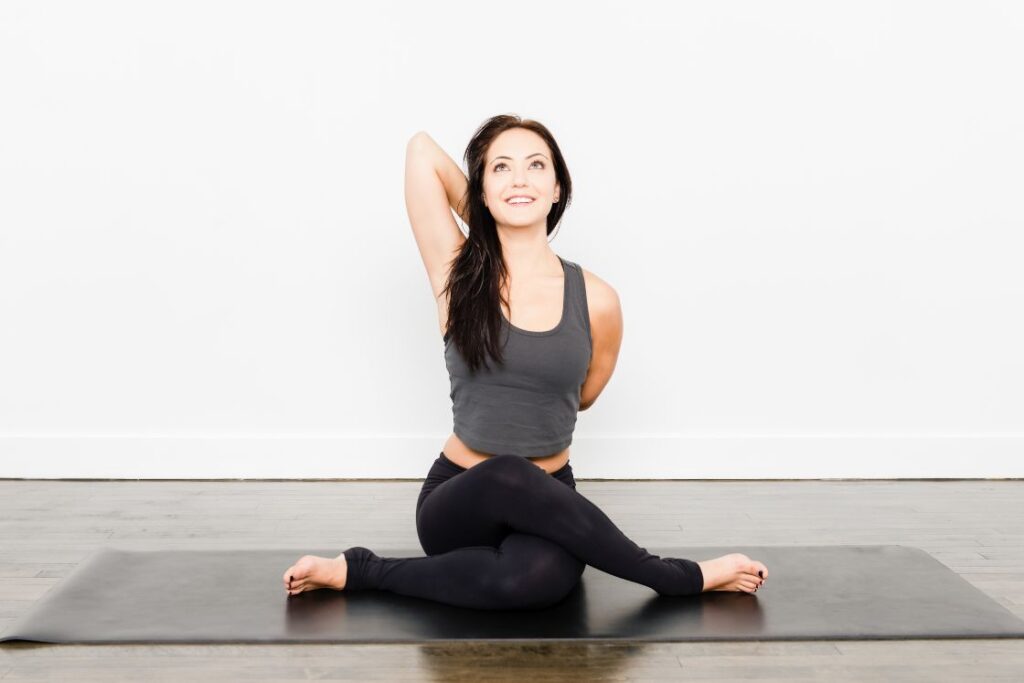
Cow face pose is one of the best yoga poses for neck and shoulder pain beginners often prefer to. This is an easy stretch and adding a strap or a towel to enhance the stretch easily makes it easier to practice. It requires clasping the hands behind the back to stretch the arms, neck, and shoulder muscles.
This pose works on improving the flexibility of the shoulders to indirectly ease the tension in neck muscles and pain around this region.
How to do
- Begin in a comfortable seated pose or by crossing the legs stacking the knees pointing the feet to the sides.
- Hold a yoga strap with your left hand and raise the left arm bending the elbow pointed upward hanging strap behind the back.
- Take your right arm behind your back bending the elbow pointing down and grasp the lower end of the strap with the right hand.
- Try to keep the hands as close as possible to enhance the stretch and hold the pose for 5 slow deep breaths.
- Then release and repeat it by switching the arms and legs position.
6. Child’s pose with elbows on the block

This is a modified version of child’s pose (balasana) that lengthens the spine and helps in opening the shoulders and back of the neck. It is practiced kneeling on the floor and lowering glutes to the heels with lengthening the spine and lowering the head to the floor.
It strengthens the upper back muscles and when the forehead rests on the block, it aligns the spine with the crown of the head. Hence, the neck muscles open up without indulging the neck into overstretching.
How to do
- Place two blocks shoulder-width apart in front of the mat.
- Assume the table-top position and from there lower your buttock to your heels.
- Reach forward to bring your elbows over the blocks and lower the forehead to the floor.
- Bend your elbows to join your palms in a reverse prayer position behind the back.
- Tuck your chin to your chest and hold the pose for 5-10 breaths.
- Additionally, you can use a rolled-up mat in place of blocks or add one more block to rest the forehead on it.
7. Standing forward bend
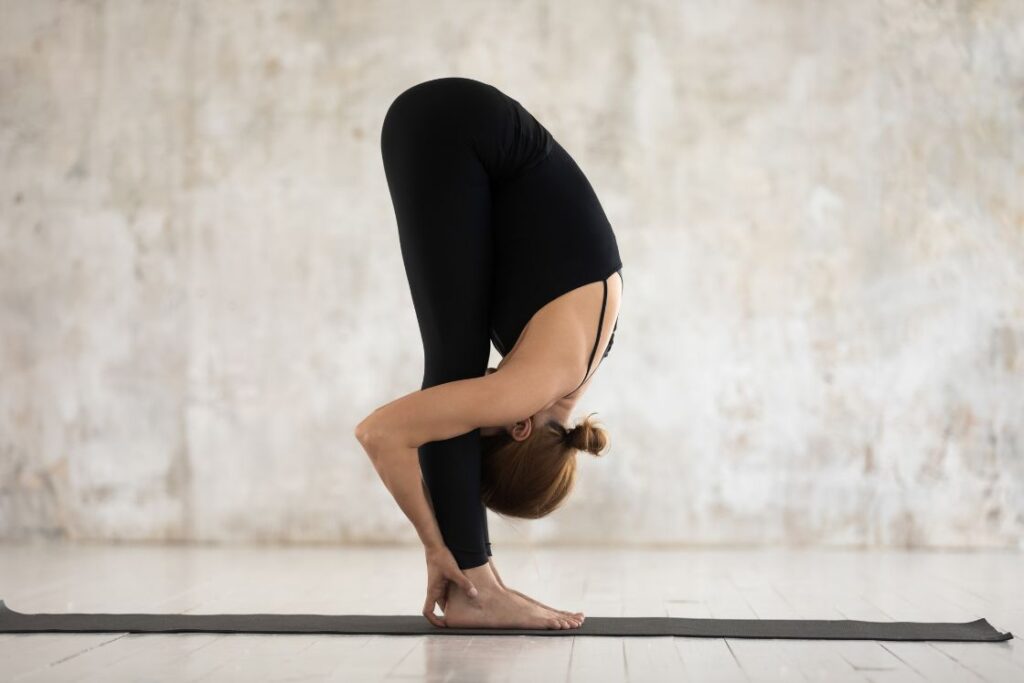
Practicing yoga for neck pain is incomplete without involving standing forward bend (uttanasana) in your practice. It is practiced flexing the upper body at the hips keeping the knees soft to reach the floor while tucking the chin to the chest.
Tucking chin to the chest and relaxing the neck in an inverted pose leaves calming effects to the spine and neck muscles, thus helps in treating the neck pain.
How to do
- Stand tall separating the legs hip-width apart and arms by the sides of your body.
- As you exhale, fold your upper body forward at the hips, keeping the knees slightly bend.
- Try to touch the floor or feet with your hands.
- Tucking your neck to chin relax your neck and head.
- You can hold your elbows with alternate hands below the head and move your head side-to-side using breath to release nay tension in and around the neck.
- Stay there for about 60 seconds and then come up to standing pose.
8. Easy seated twist pose
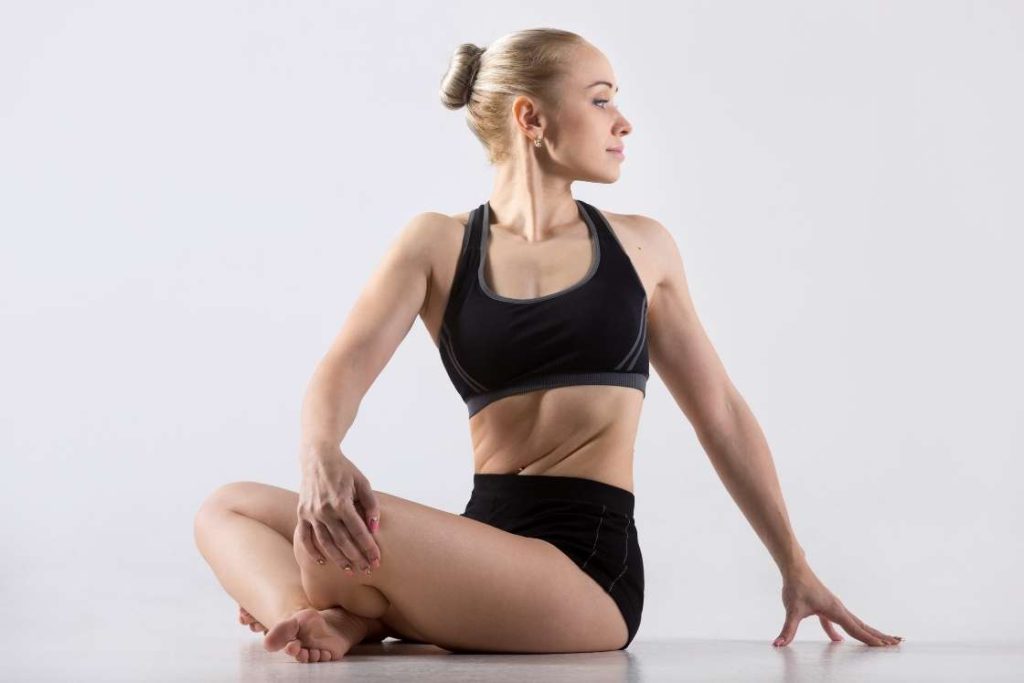
It is different from other spinal twists as it practiced assuming a symmetrical seated pose. From there, the neck is gently rotated to one side using your hands as a lever on the floor front and back of your posture.
Seated twist helps focusing on stretching the neck and back muscles gently and hence is one of the yoga asanas for back and neck pain. Allow your breath to reach your pain zone to provide relieving effects preventing the overstretching of the neck muscles.
How to do
- Begin assuming the easy pose keeping the back erect.
- Extend right arm to place the right fingertips on the floor in front and extend the left arm behind the back as far as possible to plant fingertips on the floor.
- Inhale opening the chest and lengthening the spine.
- Exhale to gently turn your body towards the left using left hand as a lever.
- Focus on turning the neck by looking over the left shoulder.
- Stay there for a couple of breaths and then gently release to the center and repeat it to the other side.
Yoga poses to avoid when having neck pain
Gentle yoga stretches can often bring relief and comfort to a sore neck. However, it’s important to recognise that some poses may overstretch the spine or strain the neck muscles making the pain worse instead of better.
If you’re experiencing neck discomfort or muscle soreness, it’s best to avoid poses that involve intense neck movement or inversion. These include:
- Inversion poses like shoulder stand and headstand compresses the neck muscles and might worsen the pain or any stiffness around the shoulder or between the vertebrae.
- Backbends like cobra, fish, or bow pose can lead to overstretching of the neck muscles and causes misalignment in the spine. Thus, these need to be prohibited when the neck muscles are already under strain.
- Try not to bend or stretch the neck beyond its neutral position in any of the poses that you choose for easing the pain.
- Avoid the plow pose that causes rounding the neck muscles and stretches the back intensely and even if you practice it, using a chair as a prop can come-in handy.
Conclusion
Knowing all ifs and buts, now you can use yoga for neck pain as your pain-relieving tool. Always listen to your body to understand the impact of any stretch on your pain points.
Include all these yoga stretches into your consistent practice to prepare your neck for your desk job and day-to-days activities promoting its strength and flexibility.

